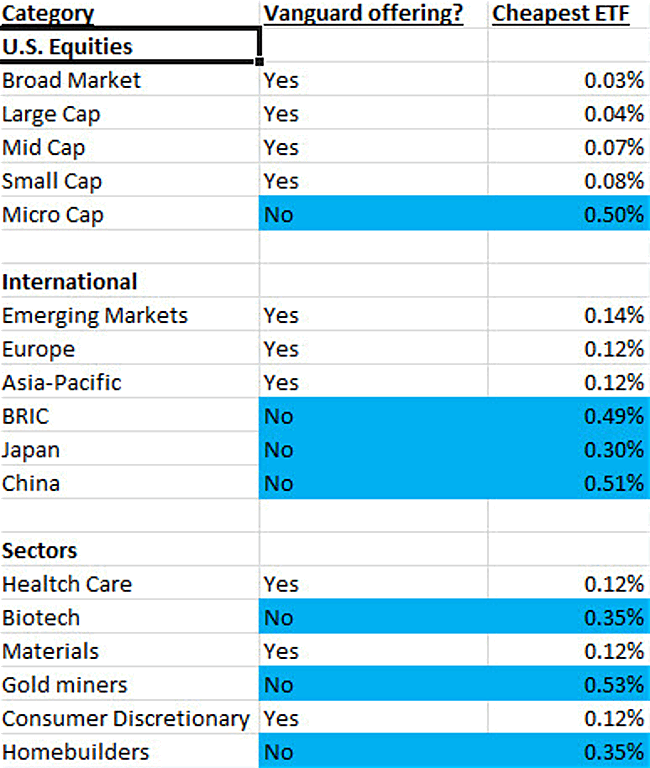 The following chart taken from this Bloomberg article by Eric Balchunas shows the drastic difference in expense ratios when Vanguard has an offering in an asset class or not.
The following chart taken from this Bloomberg article by Eric Balchunas shows the drastic difference in expense ratios when Vanguard has an offering in an asset class or not.
Like Walmart arriving in a new town, the entry of Vanguard into a particular investment area causes a collective gnashing of teeth as other fund managers are forced to drop their prices to compete. That dynamic is borne out in the table below, which shows the cheapest ETF fees for products that do or do not have a Vanguard-provided equivalent.

This is the “Vanguard Effect”. Here’s my version of explaining how it works:
- When Vanguard competes in an area, the expense ratios across the board are much, much lower.
- Note that the cheapest expense ratios you see in those asset classes not necessarily from Vanguard itself. It is often from a competitor like Charles Schwab.
- When Vanguard doesn’t compete, the expense ratios are much higher.
- In those no-Vanguard asset classes, the competitor won’t lower prices just because they can. They’ll keep the profit margin as high as they can, as they are bound to serving the business owners as well as ETF share owners. The gap between what they can charge and what they must charge goes to business profits. They aren’t evil, they are just trying to serve their two masters.
- At Vanguard, the business owner is the ETF share owner. (Vanguard uses the term “client-owned”.) For them, the most efficient way to pass on potential profits is to keep expenses as low as possible.
This is why you see DIY investors always wish Vanguard would offer something like an International Small Value ETF or a US Micro Cap ETF. By simply entering the ring, even the expense ratios of the ETFs we already hold from other providers will go down.
 The Best Credit Card Bonus Offers – March 2024
The Best Credit Card Bonus Offers – March 2024 Big List of Free Stocks from Brokerage Apps
Big List of Free Stocks from Brokerage Apps Best Interest Rates on Cash - March 2024
Best Interest Rates on Cash - March 2024 Free Credit Scores x 3 + Free Credit Monitoring
Free Credit Scores x 3 + Free Credit Monitoring Best No Fee 0% APR Balance Transfer Offers
Best No Fee 0% APR Balance Transfer Offers Little-Known Cellular Data Plans That Can Save Big Money
Little-Known Cellular Data Plans That Can Save Big Money How To Haggle Your Cable or Direct TV Bill
How To Haggle Your Cable or Direct TV Bill Big List of Free Consumer Data Reports (Credit, Rent, Work)
Big List of Free Consumer Data Reports (Credit, Rent, Work)
Does anyone know how Vanguard chooses which sectors to open ETFs in?
In my opinion, they seem to make their decisions based on demand more from financial advisors and institutional investors, and less from individual investors.
Vanguard video about their ETF’s: https://www.youtube.com/watch?v=F-OztEe8HW8
But their YouTube channel has a wealth of vids discussing topics with fund managers – I bet there’s some in-depth discussions in one of those.
I’m curious about the Vanguard’s effect on some of their recent entries, like the international dividend stocks.
Careful with ETF’s. They are a sharp knife because of how easy they are to trade. Buy and hold and dollar cost averaging of new investmant dollars has a good long term track record. For most investors 3-5 low-cost index funds plus a money market fund are all most investors need. To see how some different portfolios have performed over time you may want to checkout: portfoliocharts.com
Disclaimer: I am a senior citizen of modest means with no affiliation with any of the previously mentioned entities.